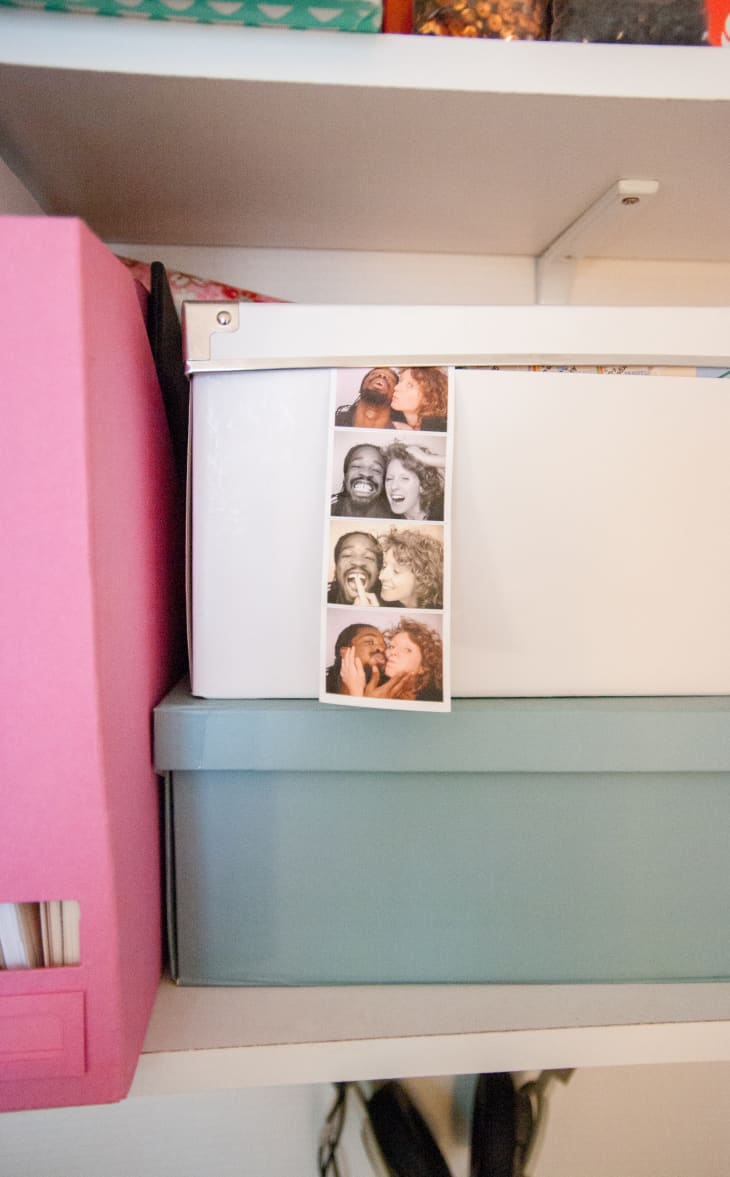How To Pluck Up, Buckle Down and Peacefully Deal With Your Most Emotionally-Charged Clutter

In general, the process of going through your things and letting go can be difficult, but it becomes even more of a struggle when you’re dealing with grief and trauma in the process. Going through a bad breakup with someone you live with, or dealing with the loss of a loved one, for example, often come with the task of going through things and deciding what to keep (and who gets what) and what to get rid of. For some, the process—while emotional of course—is fairly straightforward, for others it’s deeply upsetting and difficult to get through.
That emotional vulnerability is why Ann Lightfoot, the co-founder of Done & Done Home, a mother-daughter run organizing and decluttering business, says practicing compassion, kindness and no judgement are the most important things to remember when getting it all done.
“The emotions are very real, and stuff has—it’s infused with meaning. Every single item in your home, it’s there for some reason,” Lightfoot said. “You either chose it, you bought it, or someone gave it to you, and when you try to get rid of those things and then you start going through them, it triggers all that memory of either what you hoped would happen, where you thought you were going, where you actually went. It’s an exhausting process.”
When you’re dealing with a loss from a breakup or someone’s passing—whether recent or in the past—those emotional triggers only get stronger, Lightfoot said. “[People] want to let go of the things, but they don’t want to let go of the person,” she explained. “So it’s talking about that, it’s talking about what in your home also came from that person, what reminds you of them, what triggers your thoughts.”
Is there a simple secret to making it all easier? Lightfoot thinks so. “It’s just kindness and giving yourself enough time.”
Have a Plan for Emotional Situations
If you’re decluttering after a breakup or a separation, especially when one of you is moving out, Lightfoot has a few ground rules to follow—have the other person available (by phone, for example) but not present, and start with the items that are the easiest to divide and work your way up to the harder things.
“We start in on something that’s very clear, like your clothes are clearly your clothes—you start to build up a little strength by doing something where, [you know] your shirt is not his shirt,” Lightfoot said.
When things get murkier and you’re not sure what belongs to whom or who wants to keep something, that’s when having them available is helpful. You can send them pictures of anything that you might be unsure of. “It just keeps the emotional level low,” Lightfoot said. “And if you can, give yourself a little bit more time and maybe spread it out over a couple of days so that you can move things into your new place and start to feel positive about the future—then maybe go back and get the second round, so it’s not this crunch.”
Organizing after the loss of a loved one is a little different, of course. “The biggest thing I’ve learned, and as a mother this is super important to me, is the way these people have been treated is kind of the way they treat each other and their parents belongings,” Lightfoot said of her experiences helping siblings with estate clean-outs. “Sometimes it’s smooth sailing, there’s a feeling of kindness and love. And sometimes it’s not. Sometimes it’s miserable, everybody’s upset and they’re trying to decide how it can be fair.”
To help take some of the pressure off, Lightfoot suggests using colorful Post-It notes to help make diving things up easier. “We give everybody [their own] color Post-It, and have them put it on whatever they think they might want,” she said. In the end, some things will only have one Post-It, so it’s clear who gets it—if items have multiple tags, that’s when you’ll need to come to a decision.
It’s OK to Ask a Friend for Help
“The one thing about people getting organized on their own is that it is really hard,” Lightfoot said—that’s why she suggests calling in a friend for help (and you should always choose your kindest friend, she noted—not someone you live with or your partner, where it might get too heated). They don’t even need to do much, Lightfoot says—it’s more about having someone there to be your sidekick. “Having another person there can really keep you on track,” she said. “There’s a real reason why [some] people can’t do it.” Her advice? Having someone there who doesn’t need to be too involved and can maybe just sit in your living room with their laptop doing work, talking to you and giving you advice when you need it. “Talking it through, and sometimes even telling the story [behind an item] to another person allows you to let go,” Lightfoot said.
It’s also important to return the favor—if they help you one afternoon, make sure to be there for your friend at another time to help them get organized, too.
And when it does come time for you to help others, Lightfoot would echo the same mantra she always has: Be kind. She mentions that there are moments of human judgment that are totally normal, but you have to put that aside and go into problem-solving mode. Begin and end with kindness in mind and remember that, for that person, there’s a logical reason as to why things have become the way they are.
“There can only be compassion in helping people get through this,” she said.